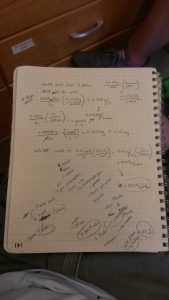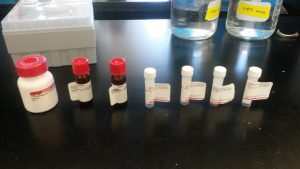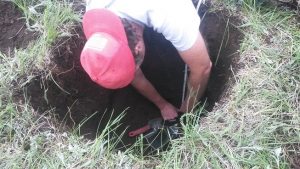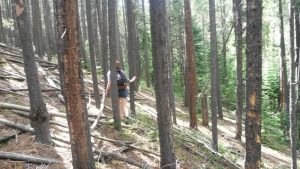June 14th, 2016
I am so exhausted after today! Since I live close by to campus I don’t typically drive so I can avoid parking fees. This week I’ve been trying a new practice: biking to the lab. I discovered that it has shaved off a lot of time in comparison to walking to campus. The only negative of not driving is that I always show up to the lab drenched in sweat and practically out of breath. Good exercise though!
This morning, Tess and I worked on making the resuscitation factor solutions. I believe I listed them in an earlier blog, but the resuscitation factors we are going to spread on the agar plates (aside from the VOCs which are gases) are pept idoglycan fragments, cyclic adenosine monophosphate (cAMP), N-acyl homoserine lactones (AHLs), humic acid, and VOCs from leaf/pine litter. Scientific literature mentions the first three substances as having influence on either manipulating microbes out of dormancy or increasing cultivation success (Puspita, Kamagata, Tanaka, Asano, & Nakatsu, 2012, p. 360-362). The other two were substances we came up with to try. We first had to calculate how much of each compound to weigh out in order to make a solution a certain concentration. I was definitely frustrated at first because it had been so long since I’d taken General Chemistry I so I’d forgotten how to calculate grams of solute from molecular weight and concentration. Tess’ explanation of the calculations were mostly just a process of thinking out loud and using mental math or mathematical shortcuts to utilize conversions. I had her walk me through the process step by step including each conversion until I was able to see a pattern. Once all of the units cancelled and I was left with grams of solute, I was satisfied and able to repeat the process for other substances. This was one of the first instances where I noticed that my mentor and I think very differently from each other in terms of mathematics. I’m wondering if I’ll eventually be as quick as her after I’ve done this for a while.
idoglycan fragments, cyclic adenosine monophosphate (cAMP), N-acyl homoserine lactones (AHLs), humic acid, and VOCs from leaf/pine litter. Scientific literature mentions the first three substances as having influence on either manipulating microbes out of dormancy or increasing cultivation success (Puspita, Kamagata, Tanaka, Asano, & Nakatsu, 2012, p. 360-362). The other two were substances we came up with to try. We first had to calculate how much of each compound to weigh out in order to make a solution a certain concentration. I was definitely frustrated at first because it had been so long since I’d taken General Chemistry I so I’d forgotten how to calculate grams of solute from molecular weight and concentration. Tess’ explanation of the calculations were mostly just a process of thinking out loud and using mental math or mathematical shortcuts to utilize conversions. I had her walk me through the process step by step including each conversion until I was able to see a pattern. Once all of the units cancelled and I was left with grams of solute, I was satisfied and able to repeat the process for other substances. This was one of the first instances where I noticed that my mentor and I think very differently from each other in terms of mathematics. I’m wondering if I’ll eventually be as quick as her after I’ve done this for a while.
Measuring out the AHLs was exceptionally frustrating since the amounts I needed to measure out were infuriatingly small. I had to use a thin metal tool to scoop out tiny amounts of the AHLs from seven different bottles which were also small. It took me a solid 45 minutes or so to measure out all seven AHLs into a small plastic tube before I could pipette in some ethyl acetate. I was relieved when it was over.
Tess informed me that she would make the other 3 solutions and spread them on the agar plates tomorrow since we were scheduled to collect soil samples up at Gordon Gulch at 1:00 PM with Noah. I was happy that I didn’t really have to worry about preparing the others but I was a little bummed that I wouldn’t be able to see how she calculated and made the other solutions. I guess I need to keep reminding myself that it’s not my responsibility to complete absolutely everything. A research project is a collaborative effort after all.
 Once 1:00 PM rolled around, we got into the car with Noah with backpacks, water, sample bags, a shovel, a sharp shooter, and some trowels and drove up to Gordon Gulch. This was my one and only field day of the summer so I was looking forward to the hike. The hike took about 30 minutes and we started off at a site in a meadow-like area at a high elevation. Noah needed to collect soil samples from various distances below the ground (approximately 1 meter below the ground) at two different sites for a separate project. Tess and I helped him dig a wide ditch, fill bags with soil, and fill the ditch back up. It was surprisingly more strenuous than I was expecting to penetrate the earth and transport heavy mounds of dirt around the ditch. I helped Noah dig in brief intervals and offered to do more digging than I was but he insisted he wanted to keep at it since he
Once 1:00 PM rolled around, we got into the car with Noah with backpacks, water, sample bags, a shovel, a sharp shooter, and some trowels and drove up to Gordon Gulch. This was my one and only field day of the summer so I was looking forward to the hike. The hike took about 30 minutes and we started off at a site in a meadow-like area at a high elevation. Noah needed to collect soil samples from various distances below the ground (approximately 1 meter below the ground) at two different sites for a separate project. Tess and I helped him dig a wide ditch, fill bags with soil, and fill the ditch back up. It was surprisingly more strenuous than I was expecting to penetrate the earth and transport heavy mounds of dirt around the ditch. I helped Noah dig in brief intervals and offered to do more digging than I was but he insisted he wanted to keep at it since he seldom had field days himself.
seldom had field days himself.
Eventually, we made our way back down to a trail that was sandwiched between a north-facing and south-facing slope. It was quite evident how different each slope was from the other. The south-facing slope had less vegetation and trees and was exposed much more directly to the sunlight, while the north-facing slope had much more vegetation and dense trees and had much less exposure to the sun. Tess and I first trekked up the south-facing slope and collected soil from the surface and down 5 cm. We repeated the process at an elevation corresponding to the previous slope on the north-facing slope. We met back up with Noah who was digging another ditch and collecting soil from an area on the north-facing side. Afterwards, we loaded all of our  backpacks with filled soil sample bags and hiked back to the car. Phew! Dirt is heavy. Especially after an 8 hour day.
backpacks with filled soil sample bags and hiked back to the car. Phew! Dirt is heavy. Especially after an 8 hour day.
I was happy to get back to the lab but not happy that I still had a bike ride to my apartment. I had enough exercise for the whole week today.
It was really gratifying to spend the day out in the field with Noah and Tess. I felt like it was a nice change-up from the constant laboratory setting and I felt like I finally got a chance to conve rse with them about topics outside of laboratory techniques and research content. Don’t get me wrong – geeking out with them about bacteria is incontrovertibly entertaining but it was nice to spend some time getting to know them for the people they are. I think it’s easy to forget that scientists aren’t simply just eggheads and analytical machines. I couldn’t be happier to have been paired up with such great mentors!
rse with them about topics outside of laboratory techniques and research content. Don’t get me wrong – geeking out with them about bacteria is incontrovertibly entertaining but it was nice to spend some time getting to know them for the people they are. I think it’s easy to forget that scientists aren’t simply just eggheads and analytical machines. I couldn’t be happier to have been paired up with such great mentors!
References
Puspita, I., Kamagata, Y., Tanaka, M., Asano, K., & Nakatsu, C. (2012). Are Uncultivated Bacteria Really Uncultivable? Microbes and Environments, 27(4), 356-366. doi: 10.1264/jsme2.ME12092
